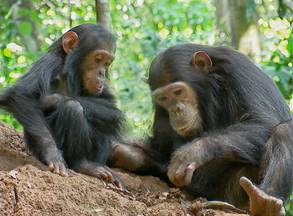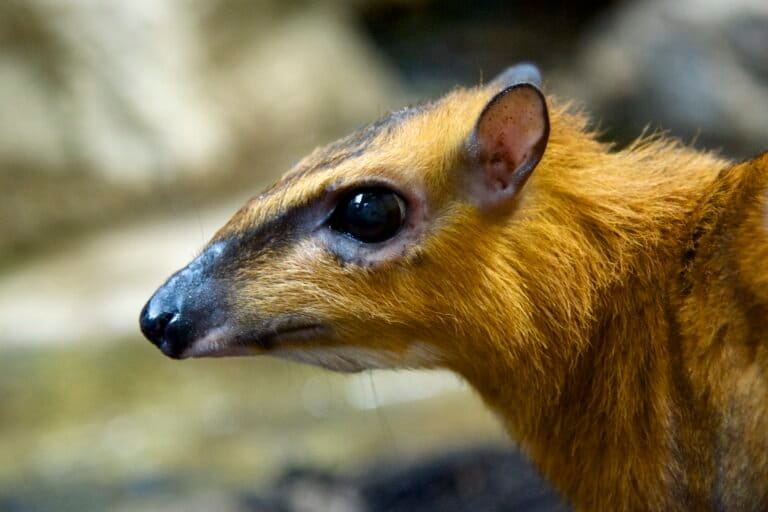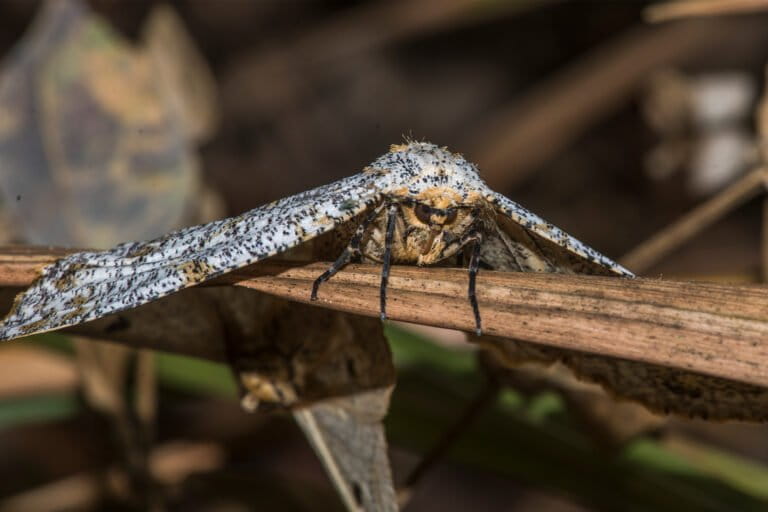Celebrating 50 years of pioneering research and sharing an inspiring vision for our future, world-renowned primatologist and conservationist Dr. Jane Goodall renews her faith in nature and humanity during the “Gombe 50” anniversary.
2010 marks a monumental milestone for the Jane Goodall Institute (JGI) and its founder, Dr. Jane Goodall, DBE. Fifty years ago, Goodall, who is today a world-renowned global conservation leader, first set foot on the shores of Lake Tanganyika, in what is now Tanzania’s Gombe National Park. The chimpanzee behavioral research she pioneered at Gombe has produced a wealth of scientific discovery, and her vision has expanded into a global mission ‘to empower people to make a difference for all living things.’
Time, however, has not stood still for Gombe. The wild chimps of the area have suffered as the local human population has swelled. Gombe National Park is now a forest fragment, a 35-square-kilometer island of habitat isolated in a sea of subsistence farming. Because the problems facing Gombe—unsustainable land practices, overpopulation, and a cycle of poverty—are typical of many other areas, lessons learned by Dr. Goodall and her team provide valuable insights for solutions at Gombe and beyond.
Mongabay first began a working dialogue with Dr. Goodall and the staff of the Jane Goodall Institute at the 2009 Wildlife Conservation Network Annual Expo in San Francisco. Dr. Goodall was the keynote speaker at this event, which showcased conservationists and environmental projects across the globe. While the primary intent of this article is to document and share a recent interview with Dr. Goodall, web links to many of the global conservation projects she supports are also included. For information regarding the 2010 WCN Expo, please visit: http://wildlifeconservationnetwork.org/events/expo2010.html.
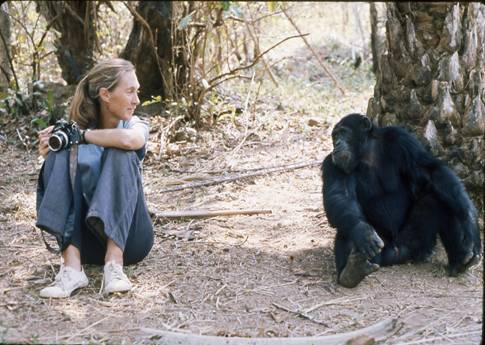 Dr. Jane Goodall with a friend at Gombe. Photo Courtesy of the Jane Goodall Institute. |
AN INTERVIEW WITH JANE GOODALL
Mongabay: Dr. Goodall, please tell our readers about ‘Gombe 50’ and what it has been like to work in the fields of wildlife research and conservation for five decades.
Dr. Jane Goodall: First of all, I think it is utterly extraordinary that it’s been half a century since I first stepped onto the shores of Gombe; that is an awfully long time. Having begun in 1960, our ongoing research of the chimpanzee community at Gombe is one of the longest documented studies of a wild animal population on record. We are still learning new things about the chimpanzees of Gombe today, as chimps can live for 50 to 60 years. And there is still so much left to learn.
Mongabay: How has the field of environmentalism changed over the past 50 years?
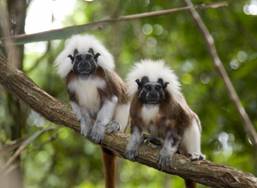 Endangered Cotton Top Tamarins of Northwest Colombia. Featured in Part Three of Dr. Jane Goodall’s Hope for Animals and Their World. And visit: http://www.proyectotiti.com/. Photo by Lisa Hoffner. |
Dr. Goodall: When I began in the early 1960s even the global scientific community wasn’t talking about—or really concerned with—conservation and environmentalism. Rainforests stretched across Africa and across the global equatorial belt but now these areas have become ever-decreasing fragments of forest. In turn, wild animal populations have suffered. Wild chimps, for example, numbered an estimated one to two million in 1900 and now there are fewer than 300,000 spread across 21 nations. The numbers of wild elephants, tigers, gorillas, rhinos, etc. have all decreased by horrific percentages.
For me, the big change in regard to my take on conservation began in the late 1980s when I realized that the problems of deforestation had come right to the borders of Gombe. I came to realize that all across Africa the chimpanzees and their forests were in real trouble. The need to reverse this catastrophic trend is what caused me to make the hard decision to leave the life that I loved out in the forest, working with the chimps in the field of primate research. Now I travel an average of 300 days a year with the mission to give people hope: ‘We can pull through our shared environmental challenges if we work together.’
The really good news is that over the past 50 years people have begun to see that the world is interconnected and that preserving the environment is a responsibility shared by all.
Mongabay: How do you feel about conservation in 2010? What is your outlook for global biodiversity?
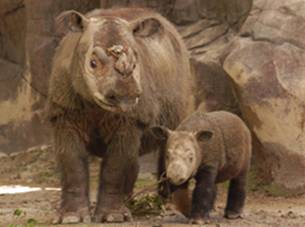 Each New Birth Gives Hope: The Critically Endangered Sumatran Rhino. Featured in Part Two of Dr. Jane Goodall’s Hope for Animals and Their World. And Visit the International Rhino Foundation at http://www.rhinos-irf.org. Photo Courtesy of the Cincinnati Zoo. |
Dr. Goodall: While it varies from place to place, there is a greater awareness of conservation and more people understand that there is a need to preserve wild places and biodiversity. But an awful lot of people across the globe cannot do much about it as they are trapped in a deep cycle of poverty. We are really at a crossroads at this point in time, and the outlook for the future depends on how we in the developed world respond to global environmental challenges and how we reach out to poor communities and help them and ourselves develop and progress along sustainable lines.
Mongabay: In your new book, Hope for Animals and Their World, you discuss multiple examples of species that have been saved ‘at the 12th hour.’ Are there species or areas that you feel are especially vulnerable, ones that may be ‘falling through the cracks?’
Dr. Goodall: Well, the planet is facing what is being called the ‘Sixth Great Extinction’ (comparable to mass extinction events like the disappearance of the dinosaurs). In places like Africa, Madagascar and the Amazon, forests are disappearing at a shocking rate.
For example, by the late 1980s around Gombe, there were no trees, and the local population of chimpanzees had grown isolated. The chimp communities north and south of the park used to spend a lot of time outside the park connecting with other forest territories and chimp groups, and now they can’t without the trees. When chimps do venture outside the park, they come into contact with people, which has led to numerous problems.
We are now losing many of the amazing animal species that share our planet, and due to unsustainable economic practices, millions of people across the world are caught in a cycle of overpopulation, poverty and disease.
This trend is reversible. Dedicated people across the globe have successfully stepped up to save wildlife and wild places against seemingly ‘impossible odds.’ It’s why I wrote my book Hope for Animals and Their World to let people know that there is hope for the world’s animals and there’s hope for us as well. These conservationists are my heroes.
Mongabay: Many ‘hotspots’ of global biodiversity are within the developing world. What’s the best way to help developing countries save their wild areas (forests)?
Dr. Goodall: Developing countries need to adopt environmentally sustainable practices and there needs to be acceptance of these practices by local people at the local level.
I will tell you about the project we developed with the local communities around Gombe called TACARE (Take Care). In ‘traditional’ economic assistance programs, people are given cash subsidies, but there is little done to solve the roots of the problems. I think the reason our reforestation and education programs have worked so well is that we don’t follow this practice. We’ve invested money into projects only after sitting down with the local leaders and village elders. Because the Tanzanian nationals who make up our team do the talking, it is understood that they represent local people not ‘outsiders.’ And the villagers embrace our projects because they choose the projects themselves. We have placed a real emphasis on micro-credit lending (loans of less than $200) to further the commitment of local people, and all of our projects are developed to be environmentally sustainable—that’s key.
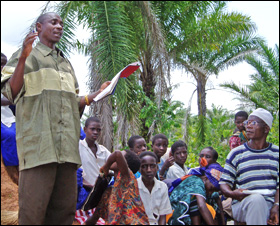 Working with the Local Community – TACARE. Photo Courtesy of the Jane Goodall Institute. |
Right now, across the globe, more people are living on the land than it can support. At Gombe, TACARE works to improve the local peoples’ lives by developing sustainable farming practices, educational scholarships, HIV-AIDS information, family planning, health care, and especially projects designed to help women and children—because all around the world as women’s education improves, family size goes down. Everyone’s quality of life improves. And we have engaged local youth in our global environmental and humanitarian youth program, Jane Goodall’s Roots & Shoots, which is fostering a new spirit of environmentalism in the next generation.
As a result, the villagers around Gombe now have a much greater understanding of the local environment and their impact on it, and have lessened practices like clear cutting and other processes that harm the forests. We’ve already seen trees coming back around many of the villages surrounding Gombe and hopefully the chimps will no longer be trapped within the tiny park.
Mongabay: What responsibilities do you feel developed countries and global corporations have in this process of helping the developing world?
Dr. Goodall: People in ‘developed’ countries need to rethink the concept of development along an environmentally sustainable model. We in the developed world have lived too long far beyond our environmental means. We need to change and we need to work with the developing nations to implement globally sustainable practices.
A greatly outdated mode of thinking in the developed world is ‘living large,’ which often has to be supported through a global ‘resource grab’ on the part of the developed nations. Big Business has too often come into conflict with conservation efforts, and in a reckless drive for profits, we all lose out.
With rapid economic development, and large populations of people in nations like China seeking ‘their share’ of the natural resources in the rest of the developing world—just as Europe had, just as America is doing—and with all the powerful nations wanting to exercise their right to their share of Africa’s, Asia’s, South America’s resources, wild areas and forest face unparalleled threats, and the local people find themselves relegated to poverty as competition for global resources heats up to reckless levels. Ultimately, there are no real winners in this competition, as we all lose out if unsustainable economic practices lead to global environmental chaos. The hollow pursuit of materialism for its own sake is crushing to the human spirit. What will future generations think of a people who had trouble thinking beyond the next shareholders meeting?
There is an enormous need for a concerted effort between the conservation groups, industry, business, NGOs, philanthropic interests and governments to foster and develop sustainable practices. There is room in this world for all of these groups, but we need to act together because, at this point in time, this is the only home that we’ve got.
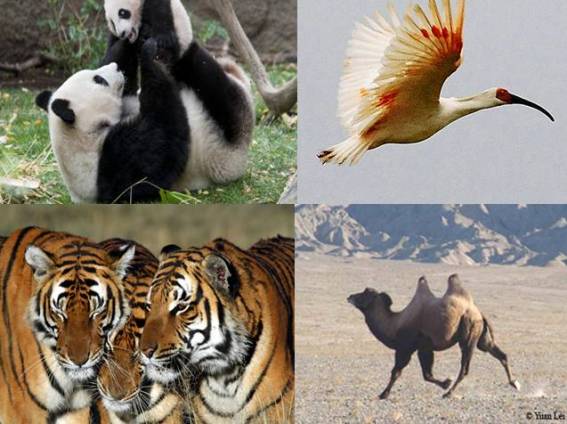 Global Groups Working Together to Save China’s Natural Treasures: The Great Panda of South China – Featured in Part Three of Hope for Animals and Their World (photo courtesy of the San Diego Zoo) Learn more about the SD Zoo’s work with the Giant Panda. Saved From the Very Brink: The Crested Ibis of Central China – Featured in Part Two of Hope for Animals and Their World The Critically Endangered South China Tiger – photo courtesy of Save China’s Tigers . Down to a Few Hundred in the Wild: The Bactrian Camel of Northern China and Mongolia – Featured in Part Three of Hope for Animals and Their World (Photo by Yuan Lei) |
Mongabay: What advice would you offer aspiring conservationists in 2010?
Dr. Goodall: I would say ‘not to give up and to get involved.’ We need to step up to the challenge now.
A real focus of my life these past years has been the development of Jane Goodall’s Roots & Shoots, the Institute’s global environmental and humanitarian program for young people from preschool to college. We now have Roots & Shoots groups in more than in 120 countries and nearly 150,000 members.
‘Roots make a firm foundation; shoots seem tiny but to reach to the sun can break through brick walls (the problems we face).’ Working with individual young people is the program’s commitment to all of us being able to make a difference, and Roots & Shoots has been so successful because the young people involved choose the projects and work together to develop solutions. They share problems, they share hopes, they share working through mistakes and together implement change. And Roots & Shoots is being shared by a generation of young people across the planet.
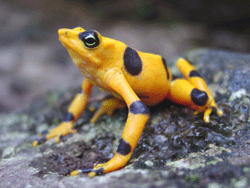 A National Symbol of Panama and Now Extinct in the Wild: The Panamanian Golden Frog Featured in Part Three of Hope for Animals and Their World. To learn more about the spectacular biodiversity of Panama and how You can help safeguard the area’s natural treasures visit http://ecoreserve.org/ . |
And there are all kinds of wonderful conservation groups across the globe. In your part of the world (California) there are groups like the Wildlife Conservation Network, and new projects like EcoReserve, which will allow a greater number of people to participate directly in global conservation through ‘micro-conservation’ projects. There are so many opportunities for people to step up in a positive, lasting and meaningful way—to think globally and live locally.
Mongabay: Dr. Goodall, you have a famous quote: ‘Every individual matters. Every individual has a role to play. Every individual makes a difference.’ Please relate this line of thinking to ideas about how each of us can help preserve biodiversity through our actions.
Dr. Goodall: People feel that they are helpless to solve problems facing the global environment; that the problems are too large to be dealt with on an individual basis. But every single day we all make an impact on the world through the choices we make. And we all have the responsibility to carefully consider our choices.
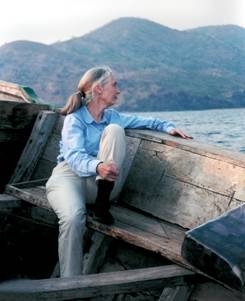 On the Shores of Lake Tanganyika. Photo Courtesy of the Jane Goodall Institute .
|
Are we living beyond our real needs, what is our individual carbon footprint, was there unnecessary waste or cruelty (product testing with live animal subjects) involved in the production of the goods that we buy? There is so much access to information these days; we can all make educated choices. And with the wonders of modern communication, the positive little changes that people make will multiply, first by hundreds, then by thousands, then millions; by working together we can effect big global change! We must take stock of and accountability for our actions, and we must be better global stewards than we have been for the sake of future generations.
And if people are still feeling helpless, I would ask that they have faith in the resilience of nature and the power and capacity of the human brain. We have an amazing brain; it’s taken us to the moon, discovered the wonders of modern medicine and built a global information super highway. We have the ‘stuff,’ the problem-solving skills, the communication abilities, and a drive to progress that will allow us to work through today’s environmental challenges.
After 50 years, my job is now to give people hope.
Hope for Animals and Their World
Video from the Jane Goodall Institute (JGI) about its work in Africa and around the world.



